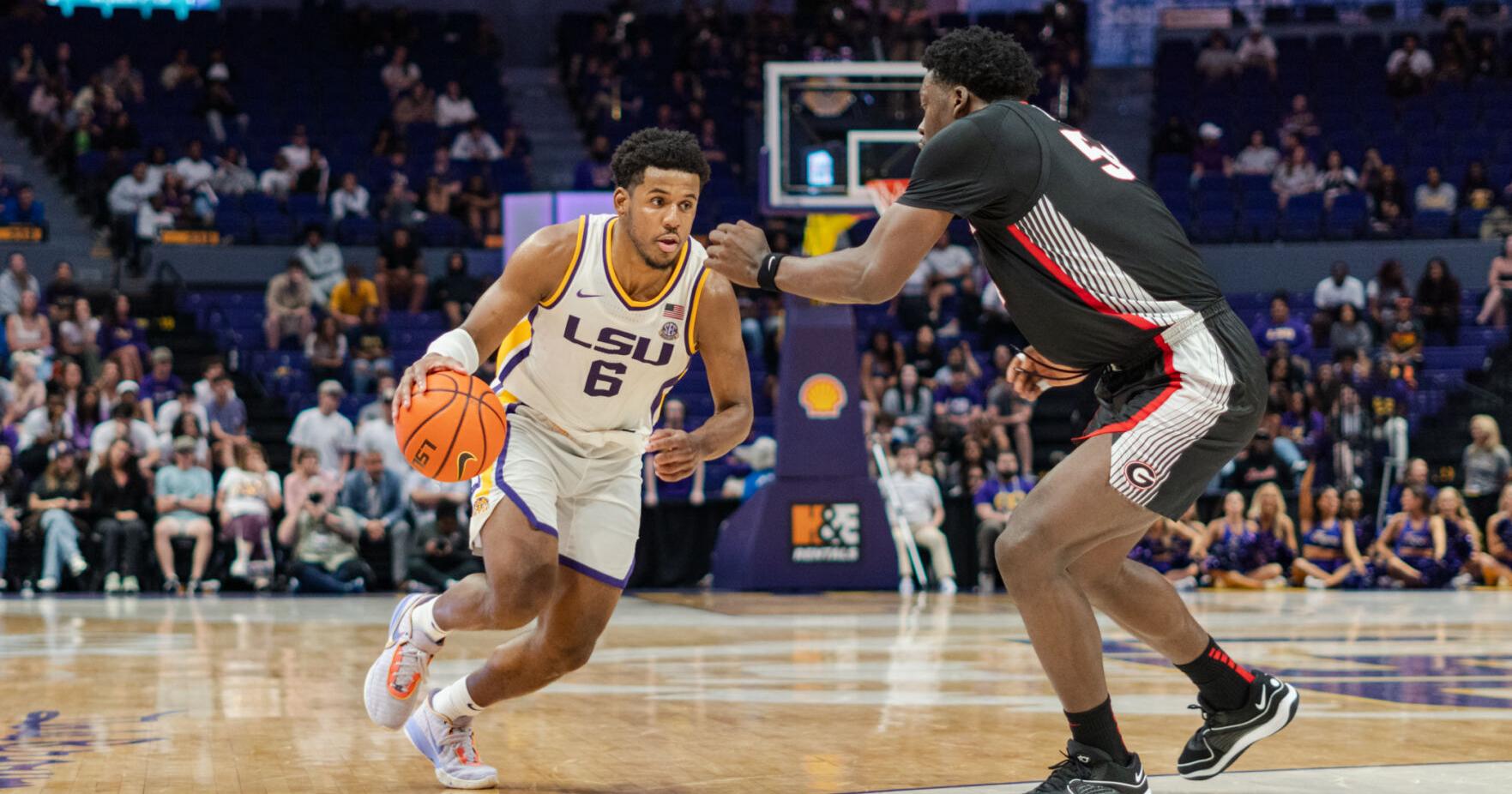Sports
Men's basketball may be changing the two halves game format | Sports – The Reveille, LSU's student newspaper

LSU men’s basketball graduate student guard Jordan Wright (6) drives in Tuesday, Feb. 27, 2024, during LSU’s 67-66 win against Georgia in the Pete Maravich Assembly Center in Baton Rouge, La.
LSU men’s basketball graduate student guard Jordan Wright (6) drives in Tuesday, Feb. 27, 2024, during LSU’s 67-66 win against Georgia in the Pete Maravich Assembly Center in Baton Rouge, La.
In 1954, men’s college basketball coaches from all across the country met in the grand ballroom of the Hotel Muehlebach in Kansas City, Missouri, to decide if future games should be split into four ten-minute quarters or two 20-minute halves.
Little did the attendees know, their decision would be very impactful. In 2024, seven decades from that faithful gathering in a Kansas City hotel ballroom, the men’s game is still played in two 20-minute halves.
In 1891, Dr. James Naismith created the game of basketball. In his original rulebook, Naismith stated that the game would be “played in two 15-minute halves with rest time in between.”
Across the NBA, WNBA, FIBA and even its NCAA sister, women’s college basketball, men’s collegiate hoops is the only one to stick with the two-half system Naismith originally envisioned.
But Naismith’s idea of two 15-minute halves needed to be longer for high-scoring, competitive basketball games. In 1905, the NCAA adopted what we are familiar with today, bumping games up to two 20-minute halves rather than 15.
In 1951, the NBA and NCAA agreed to have their games consist of four 10-minute quarters. While the NBA doubled down on quarters, adding two minutes to each in 1954, the NCAA decided to backtrack and return to the two 20-minute halves, and the rest is history. But why?
Why would the NCAA turn around and go back to halves?
Two long stretches of play rather than four shorter, broken-up quarters allow for a unique rhythm that only men’s college basketball has. The naturally faster pace allows less margin for error, even if the players aren’t as refined and have as well-rounded games as the pros.
The idea behind speeding up the flow of men’s college basketball games through halves sounds excellent if the NCAA’s rules didn’t counteract nearly all the benefits that come with it.
College basketball didn’t even have a shot clock until 1985, over thirty years after the NBA adopted the 24-second shot clock in 1954. It started at 45 seconds and dropped to 35 seconds in 1993.
When offensive numbers hit a lull in 2015, the NCAA counteracted with a 30-second shot clock, which helped offenses from averaging in the 60s in the years before to now averaging somewhere in the low 70s since the change.
But 30 seconds still feels a little too long. If the NCAA adopted the 24-second shot clock, it would help its players further prepare for the pros while increasing game speed, scoring and excitement. While there will definitely be some ugly growing pains, adopting the 24-second shot clock will only make the game better over time.
But nothing kills the flow of a basketball game like fouls, and lots of them.
After committing six fouls in a single half of a men’s collegiate game, any foul afterward will send the opposing team to the free-throw line. In the NBA, any foul after a player’s fourth in a quarter will result in free throws for the opposition.
That’s an extra eight minutes in men’s college basketball compared to the NBA between foul resets. With fewer foul resets come even more free-throw stoppages.
Fouls also tend to pile up at the collegiate level with less experienced and skilled defenders than in the NBA. This leads to an assortment of free throws at the end of men’s college basketball games that completely ruin the flow of what should be the most exciting point in the game.
So, if quarters are the better system, why keep the halves?
In 2015, the NCAA changed the women’s game from two twenty-minute halves to four ten-minute quarters. The NCAA’s Playing Rules Oversight Panel and the WBCA’s Board of Directors believed quarters would enhance the game’s flow by reducing TV timeouts and free throw attempts.
In games played in halves, there are four media timeouts per half while games played in quaters only have three. The idea was that the NCAA could afford to try the four-quarter system with women’s college basketball, as it was far from the cash cow that was the men’s game.
But in 2024, that same ideology is a very outdated way of thinking.
Monday night’s historic clash between LSU and Iowa in the Elite Eight set a women’s NCAA basketball record with 12.3M viewers. It was the most-watched college basketball game on ESPN, between men’s and women’s teams, and the most-watched women’s college basketball game in history.
If the now highly marketable women’s game can afford to play through the more effective quarter system, why can’t the men’s? The NCAA doesn’t have any more excuses.
While halves may be how Naismith originally intended the game to be played, the quarter system has shown effectiveness across other basketball environments. Accompanying some other small rule changes, the NCAA can improve its product by switching back to quarters.
{{description}}
Email notifications are only sent once a day, and only if there are new matching items.
If you’re interested in submitting a Letter to the Editor, click here.
Got a question? Want to share an anonymous news tip? Click “Submit” to let the Reveille’s student journalists know.
Your browser is out of date and potentially vulnerable to security risks.
We recommend switching to one of the following browsers:









